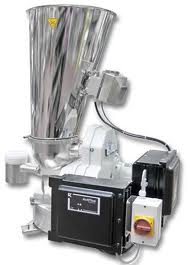Flow Aid Systems
The addition of Flow Aids, for example fumed silica, is sometimes used to reduce the cohesive strength of difficult to handle products. Similarly, anti-caking, desiccant, antistatic and lubricating additives are used for various applications. There remain many circumstances where gravity flow design is not feasible. For such applications, a discharge system must be used to achieve reliable discharge. For example:
- Where the poor flow nature of the material requires a larger outlet size than is compatible with the feeder of choice or the downstream process. Fibrous, interlocking, spring-like, wet / moist, stick & tacky, visco-elastic, highly compressible, soft, caking-prone and very fine powders exemplify such materials.
- Uncontrolled variability in the material flow properties makes it difficult to ensure a reliable design.
- Where current space constraints, usually headroom and especially in retrofit situations, do not allow the use of steep walled hoppers.
- The discharge rate of the size of hopper outlet needed for reliable flow is either too high, too low or needs to be controlled to suit subsequent equipment.
Ideally, the prospect of using a discharge system should be identified at the initial design stage of storage silos and details appropriately factored into the structure, including stress calculations and headroom for installation and maintenance. Failure to do so may seriously impede the choice of initial equipment or seriously limit the options for retrofit. It is good practice to include some spare headroom, wherever practical.
